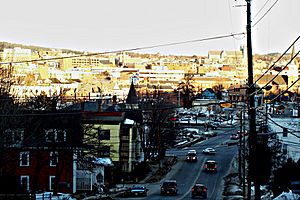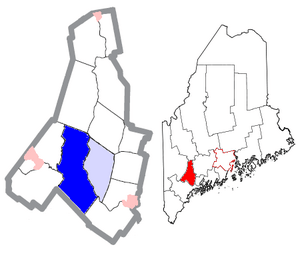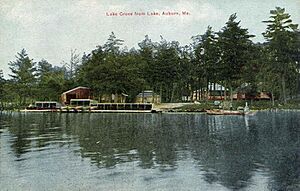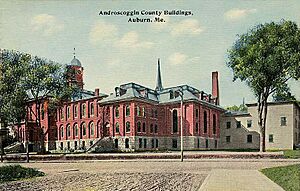Auburn, Maine facts for kids
Quick facts for kids
Auburn, Maine
|
||
|---|---|---|
 |
||
|
||
| Motto(s): | ||

Location of Auburn, Maine (in dark blue)
|
||
| Country | ||
| State | ||
| County | Androscoggin | |
| Incorporated (town) | February 24, 1842 | |
| Incorporated (city) | February 22, 1869 | |
| Neighborhoods | Danville East Auburn Littlefield Corner Marston Corner New Auburn North Auburn Stevens Mill |
|
| Area | ||
| • Total | 65.74 sq mi (170.27 km2) | |
| • Land | 59.34 sq mi (153.69 km2) | |
| • Water | 6.40 sq mi (16.58 km2) | |
| Elevation | 190 ft (58 m) | |
| Population
(2020)
|
||
| • Total | 24,061 | |
| • Density | 405.48/sq mi (156.56/km2) | |
| Time zone | UTC−5 (Eastern) | |
| • Summer (DST) | UTC−4 (Eastern) | |
| ZIP codes |
04210-04212
|
|
| Area code(s) | 207 | |
| FIPS code | 23-02060 | |
| GNIS feature ID | 0561347 | |
Auburn is a city in south-central Maine, in the United States. It is the main city of Androscoggin County. In 2020, about 24,061 people lived there. Auburn and its nearby city, Lewiston, are often called the Twin Cities or Lewiston–Auburn (L–A).
Contents
History of Auburn
Early Settlement and Growth
The land where Auburn is now was first bought in 1714. This was after a peace agreement between the Abenaki Native Americans and settlers. However, there were arguments over who owned the land. Because of this, people didn't start settling there until after the French and Indian Wars.
Auburn was first settled in 1786. It was part of a larger area called Bakerstown. Later, it became part of a town called Minot. Auburn officially became its own town on February 24, 1842. The name "Auburn" might have come from a poem called "The Deserted Village" by Oliver Goldsmith.
In 1854, Auburn became the main city for Androscoggin County. The city grew bigger by adding land from nearby towns. On February 22, 1869, Auburn became a city. In 1917, it was the first city in Maine to use a council-manager government. This means a city manager runs the city's daily business.
Industry and Development
At first, farms grew food for the area. But after a bridge was built to Lewiston in 1823, and a railroad arrived in 1848, Auburn became a mill town. Mills used water power from the Androscoggin River to make things.
In 1835, the first shoe factories started in Auburn. Other factories made cloth, carriages, and furniture. By 1890, Auburn's population had grown a lot. This was because many French Canadian immigrants came to work in the shoe factories.
Shoe making became the most important industry in Auburn by the late 1800s. The city's official seal even shows a spindle with different types of shoes. This showed that Auburn was a major shoe manufacturing center. In 1917, one factory in Auburn made 75% of the world's white canvas shoes! However, after World War II, the shoe industry started to slow down. Many large factories closed between 1957 and 1961.
Important Events
In 1985, the area became known because of a plane crash. This crash sadly took the life of Samantha Smith, a young peace activist.
In 2023, Joe Biden visited Auburn. He was the first sitting U.S. president to visit the city in 111 years. The last one was William Howard Taft in 1912.
Lewiston-Auburn Shoe Strike
In 1937, a big event happened in Lewiston and Auburn. It was called the Lewiston-Auburn Shoe Strike. This was when many workers stopped working to ask for better conditions. About 4,000 to 5,000 workers were involved. When workers tried to march, the Governor sent in the Maine Army National Guard to keep order. Some leaders of the workers were even put in jail for a few months.
Geography
Auburn is located at 44°5′N 70°14′W / 44.083°N 70.233°W. The city covers about 65.74 square miles (170.27 square kilometers). Most of this area is land, and about 6.41 square miles (16.58 square kilometers) is water. The Little Androscoggin River and Androscoggin River flow through Auburn.
Population Information
| Historical population | |||
|---|---|---|---|
| Census | Pop. | %± | |
| 1850 | 2,840 | — | |
| 1860 | 4,022 | 41.6% | |
| 1870 | 6,169 | 53.4% | |
| 1880 | 9,555 | 54.9% | |
| 1890 | 11,250 | 17.7% | |
| 1900 | 12,951 | 15.1% | |
| 1910 | 15,064 | 16.3% | |
| 1920 | 16,985 | 12.8% | |
| 1930 | 18,571 | 9.3% | |
| 1940 | 19,817 | 6.7% | |
| 1950 | 23,134 | 16.7% | |
| 1960 | 24,449 | 5.7% | |
| 1970 | 24,151 | −1.2% | |
| 1980 | 23,128 | −4.2% | |
| 1990 | 24,039 | 3.9% | |
| 2000 | 23,203 | −3.5% | |
| 2010 | 23,055 | −0.6% | |
| 2020 | 24,061 | 4.4% | |
| 2022 (est.) | 24,193 | 4.9% | |
| sources: | |||
Auburn is one of the two main cities in the Lewiston-Auburn area. This area is part of a larger group of cities and towns in Maine.
2010 Census Details
In 2010, there were 23,055 people living in Auburn. There were 9,974 households, and 5,818 families. The city had about 388.6 people per square mile.
Most people in Auburn were White (93.7%). About 2.5% were African American, and 0.9% were Asian. About 1.5% of the population was Hispanic or Latino.
The average age in the city was 39.9 years old. About 22.1% of residents were under 18. About 15.2% were 65 years or older. There were slightly more females (51.7%) than males (48.3%).
Education
The Auburn School Department provides public schools for kids. This includes Edward Little High School.
Other schools in Auburn are:
- St. Dominic Regional High School, a Catholic high school
- Central Maine Community College, a college for higher education
Media
Newspapers
- The Sun Journal is a daily newspaper. It prints two different versions across the state. It has won awards for being a top newspaper in New England and Maine.
Transportation
Roads
Several important roads go through Auburn:
- Interstate 95
- US Route 202
- State Route 11
- State Route 4
- State Route 121
- State Route 136
- State Route 122
By Air
Auburn has its own airport. It is called the Auburn/Lewiston Municipal Airport. You can find it off Hotel Road.
Rail
Two freight train lines run through Auburn. Pan Am Railways is the main one. Its main line goes through Auburn, following US Route 202. The St. Lawrence and Atlantic Railroad also has a line that passes through the city.
Places to Visit
- Lost Valley Ski Area: A great place for skiing and snowboarding.
- Mount Apatite Park: A park for outdoor activities.
- Auburn Riverwalk: A path along the Androscoggin River.
- Lake Auburn: A beautiful lake.
- Festival Plaza: A public park and performance area. It has two cool water sculptures. One shows the Androscoggin River. The other has bronze shoes, remembering Auburn's shoe making past.
- Hamster Point: Lovely gardens by the river.
- Auburn Mall: A place to shop.

- Androscoggin Historical Society & Museum: Here you can see old items from local history. They have things from the American Civil War, old farming tools, and a bird collection.
- Knight House Museum (1796): This is the oldest wooden house downtown. It also has an old shoe shop from before 1835.
- Auburn Fire Department Museum: This museum has a collection of old fire equipment from the city.
- Good Shepherd Food Bank: This organization helps distribute food to people across the state from its main building in Auburn.
Historic Buildings
Many buildings in Auburn are listed on the National Register of Historic Places. This means they are important for their history or architecture.

Some of these historic places include:
- A. A. Garcelon House (1890)
- Androscoggin County Courthouse and Jail (1857)
- Auburn Public Library (1903)
- Barker Mill (1873)
- Charles A. Jordan House (1880)
- Charles L. Cushman House (1889)
- Edward Little House (1827)
- Engine House (1879)
- First Universalist Church (1876)
- Frank L. Dingley House (1867)
- Free Baptist Church
- Gay-Munroe House (1878)
- Holman Day House (1895)
- Horace Munroe House (1899)
- Horatio G. Foss House (1914)
- Lamoreau Site
- Main Street Historic District
- Roak Block (1871)
- William A. Robinson House (1874)
- William Briggs Homestead (1797)
Famous People From Auburn
Many notable people have connections to Auburn, including:
- Tony Atlas, a wrestler
- John Bower, a skier
- Lenny Breau, a jazz guitarist
- Erwin Canham, a journalist and author
- Alonzo Conant, a judge
- Aaron S. Daggett, a Civil War general
- T. A. D. Fessenden, a U.S. congressman
- Sara Mae Stinchfield Hawk, a speech pathologist
- John Jenkins, a mayor
- Adam R. Lee, a state legislator
- Edward Little, a philanthropist and educator
- Robert Luce, a U.S. congressman
- Cynthia McFadden, a TV news correspondent
- Dana T. Merrill, a U.S. Army general
- Elmer Drew Merrill, a botanist
- George Perkins Merrill, a geologist
- Julie Parisien, a skier
- Deborah Simpson, a state legislator
- Billy Silverman, a referee
- Charles Small, a baseball player for the Boston Red Sox
- Olympia Snowe, a U.S. senator and congresswoman
- Peter T. Snowe, a Maine state legislator
- John H. Sturgis, a Maine state legislator
See also
 In Spanish: Auburn (Maine) para niños
In Spanish: Auburn (Maine) para niños










